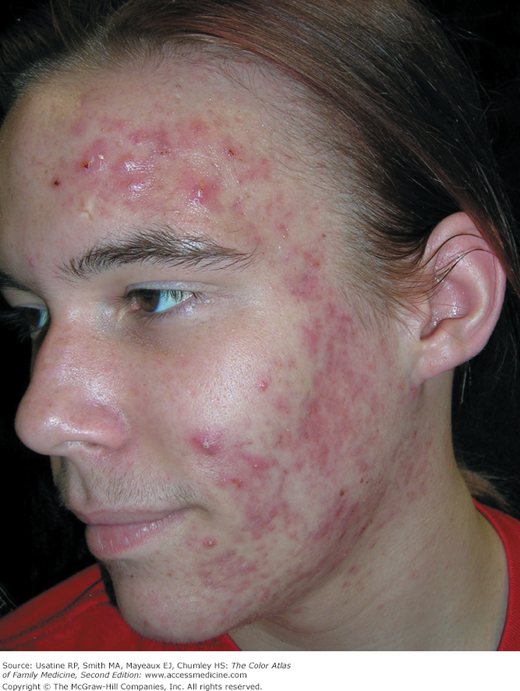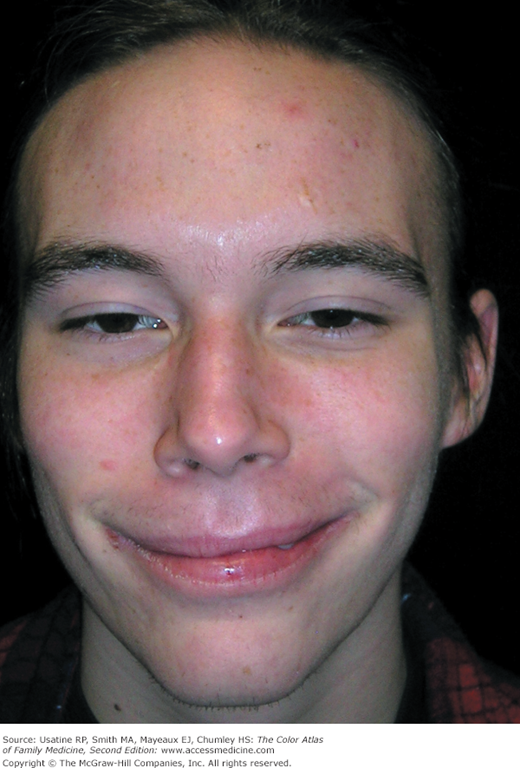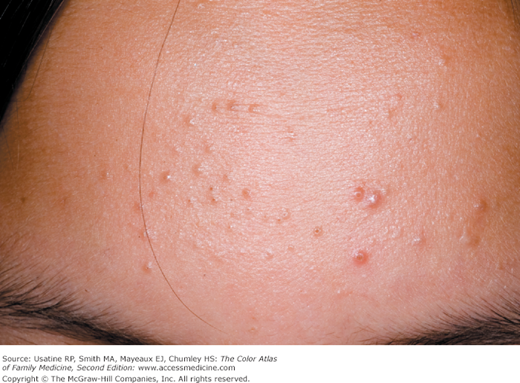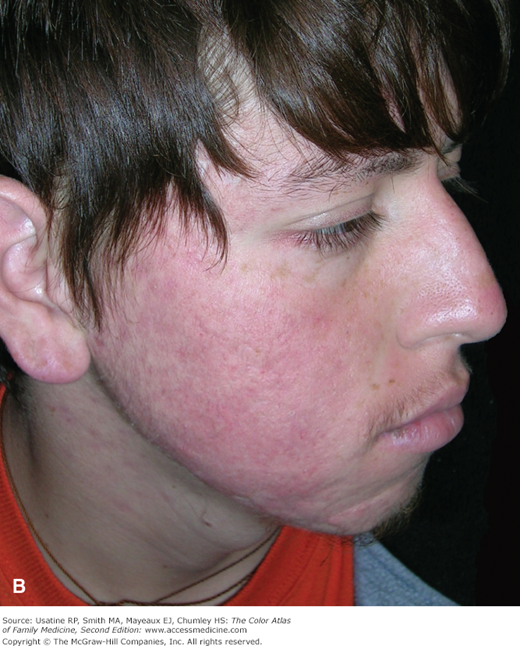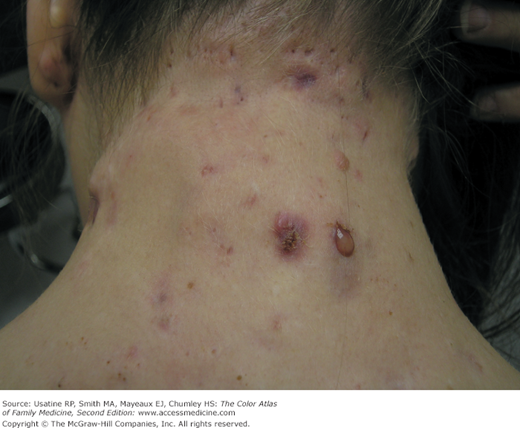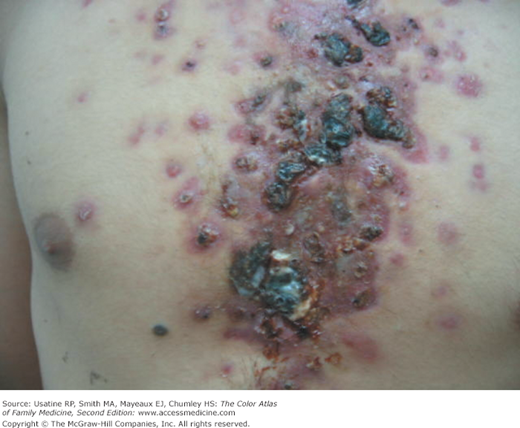Patient Story
A 16-year-old boy (Figure 112-1) with severe nodulocystic acne and scarring presents for treatment. After trying oral antibiotics, topical retinoids, and topical benzyl peroxide with no significant benefit, the patient and his mother request isotretinoin (Accutane). After 4 months of isotretinoin, the nodules and cysts cleared and there remained only a few papules (Figure 112-2). He is much happier and more confident about his appearance. The skin cleared fully after the last month of isotretinoin.
Introduction
Epidemiology
Acne vulgaris affects more than 80% of teenagers, and persists beyond the age of 25 years in 3% of men and 12% of women.1
Etiology and Pathophysiology
Sebum overproduction related to androgenic hormones and genetics.
Abnormal desquamation of the follicular epithelium (keratin plugging).
Propionibacterium acnes proliferation.
Follicular obstruction, which can lead to inflammation and follicular disruption.
Acne can be precipitated by mechanical pressure as with a helmet strap (Figure 112-4) and medications such as phenytoin and lithium (Figure 112-5).
There are some studies that suggest that consumption of large quantities of milk (especially skim milk) increase the risk for acne in teenagers.2
Diagnosis
Morphology of acne includes comedones, papules, pustules, nodules, and cysts.
- Obstructive acne = comedonal acne = noninflammatory acne and consists of only comedones (Figure 112-6).
- Open comedones are blackheads and closed comedones are called whiteheads and look like small papules.
- Inflammatory acne has papules, pustules, nodules, and cysts in addition to comedones (Figure 112-5).
None unless you suspect androgen excess and/or polycystic ovarian syndrome (PCOS).3 SOR A Obtain testosterone and DHEA-S levels if you suspect androgen excess and/or PCOS.
Consider follicle-stimulating hormone (FSH) and luteinizing hormone (LH) levels if you suspect PCOS.
Differential Diagnosis
- Acne conglobata is an uncommon and unusually severe form of acne characterized by multiple comedones, cysts, sinus tracks, and abscesses. The inflammatory lesions and scars can lead to significant disfigurement.4 Sinus tracks can form with multiple openings that drain foul-smelling purulent material (Figures 112-7, 112-8 and 112-9). The comedones and nodules are usually found on the chest, the shoulders, the back, the buttocks, and the face. In some cases acne conglobata is part of a follicular occlusion triad including hidradenitis and dissecting cellulitis of the scalp (Figure 112-9).
- Acne fulminans is characterized by sudden onset ulcerative crusting cystic acne, mostly on the chest and back (Figures 112-10 and 112-11).5 Fever, malaise, nausea, arthralgia, myalgia, and weight loss are common. Leukocytosis and elevated erythrocyte sedimentation rate are usually found. There may also be focal osteolytic lesions. The term acne fulminans may also be used in cases of severe aggravation of acne without systemic features.5
- Rosacea can resemble acne by having papules and pustules on the face. It is usually seen in older adults with prominent erythema and telangiectasias. Rosacea does not include comedones and may have ocular or nasal manifestations (Chapter 113, Rosacea). Rosacea fulminans or pyoderma faciale has features of severe acne and rosacea (Figure 112-12).
- Folliculitis on the back may be confused with acne. Look for hairs centrally located in the inflammatory papules of folliculitis to help distinguish it from acne. Acne on the back usually accompanies acne on the face as well (Chapter 117, Folliculitis).
- Acne keloidalis nuchae consists of papules, pustules, nodules, and keloidal tissue found at the posterior hairline. It is most often seen in men of color after shaving the hair at the nape of the neck (Chapter 114, Pseudofolliculitis and Acne Keloidalis Nuchae).
- Actinic comedones (blackheads) are related to sun exposure and are seen later in life (Figure 112-13).
Figure 112-7
A. Acne conglobata in a 16-year-old boy. He has severe cysts on his face with sinus tracks between them. He required many weeks of oral prednisone before isotretinoin was started. His acne cleared completely with his treatment. B. Acne conglobata cleared with minimal scarring after oral prednisone and 5 months of isotretinoin therapy. (Courtesy of Richard P. Usatine, MD.)
Figure 112-9
Acne conglobata in a 53-year-old man covered with open comedones and cysts on his back. He has the follicular occlusion triad including hidradenitis, dissecting cellulitis of the scalp and acne conglobata. (From Grunwald MH, Amichai B. Nodulo-cystic eruption with musculoskeletal pain. J Fam Pract. 2007;56(3):205-206, Reproduced with permission from Frontline Medical Communications.)

